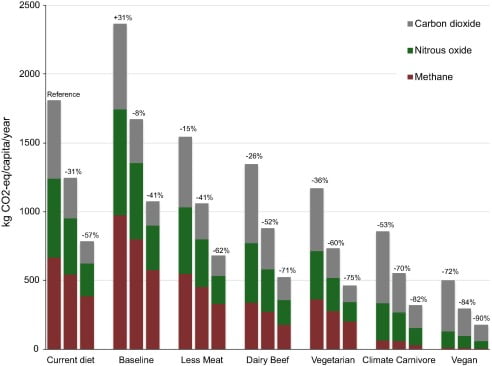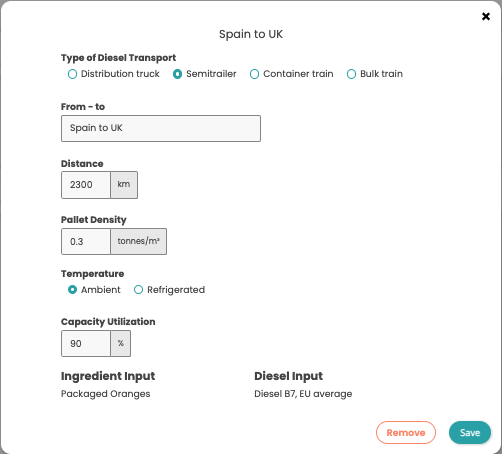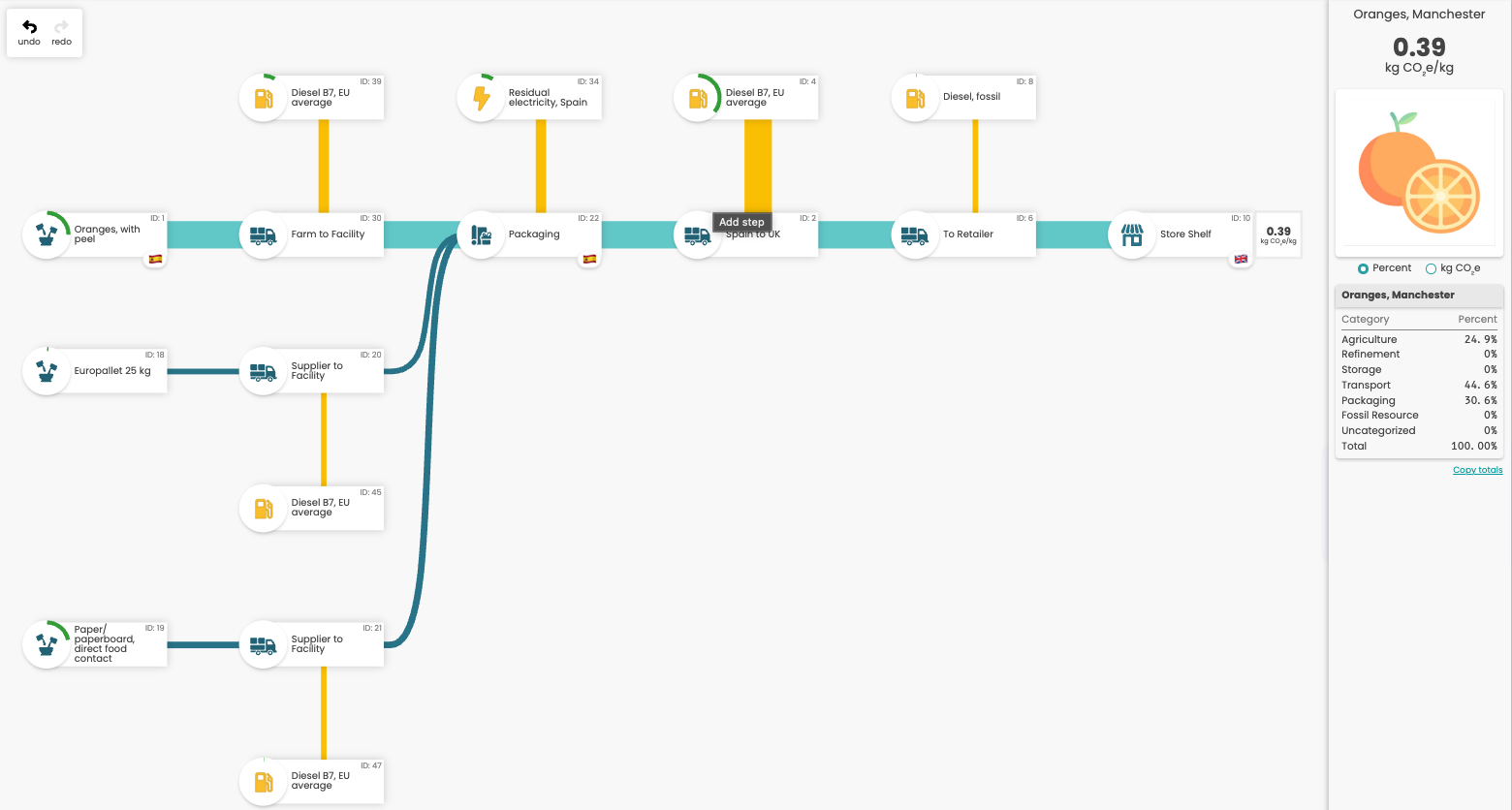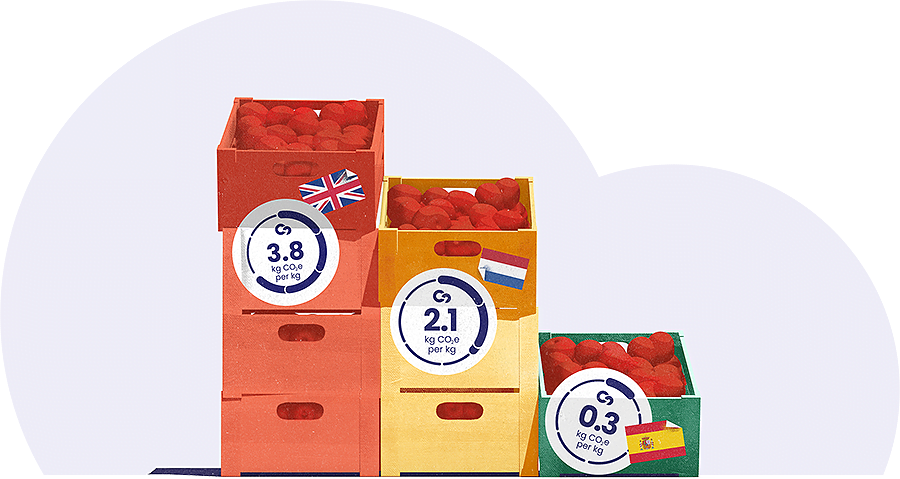EBOOK
The 6 most frequent misconceptions about the climate impact of food
We know consumers care about the climate impact of their food. However, in lieu of industry-wide climate transparency, most consumers are left to their own devices to conclude what food is climate-friendly and what isn’t. Are they right?
With the Knowvember social listening report, we listened in on the climate discussions Brits are having about food in every corner of the internet, so you can engage your audience with data – and based on data!
In this ebook, we present the most frequently discussed topics, the facts (they don’t call it climate science for nothing!), how you can engage the climate-conscious consumer base on the topics and help them make informed choices.
Let’s crack down the 6 most frequent presumptions of consumers on the climate impact of food, whether they are right, and how to engage them.
What are consumers passionate about? What makes them jot down their thoughts and click Send? We discovered another dimension – do audience opinions align with facts on climate change? And, can facts address their concerns?
An overview of the most discussed misconceptions
1. "We all have to go vegan"
58% of the conversation about the climate impact of food revolved around meat, dairy, and the effect of cutting out or reducing the consumption of these products. Some posters were positive about reducing their consumption of animal products. Others were reluctant, with concerns about the nutritional impact, an increase in processing, and even a higher footprint that comes from increased processing. But is veganism the only solution for a climate-smart diet?
Download the pdf and listen in on consumer discussions!
The audience has it right: Meat and dairy products typically do have a higher climate footprint. However, not all meat (#notallmeat?) has a similarly high footprint.
The facts

Mostly ruminant products are in the high-category zone. The high climate footprint comes from enteric fermentation emitting methane as well as the need for greater land use. In addition, there are also agricultural products usually associated with deforestation with a similarly high climate footprint, such as cocoa, rice, and coffee beans that need to be upheld in the same category of caution.
Moreover, refinement and production –what the audience perceives as processing– commonly accounts for under 10% of the total footprint of food.
In the 20 years to 2018, global meat consumption rose by 58% [1] and animal farming accounts for 57% of emissions from the food system [2]. Meat consumption is the largest opportunity for emissions reductions related to food and choosing plant-based is a safe and effective rule of thumb for a lower climate footprint. However, the reality is more nuanced than that and there is room for meat in a climate-smart diet. Data from the study below supports it.

According to this study, while a plant-based diet is the option with the lowest footprint, a vegetarian diet can have a higher climate footprint than the diet including pork and chicken [3].
The solution
It is simplistic to say “facts are facts”, as much plant-based diets as the climate-optimal choice is a fact. But people don’t just eat with their brains – they eat with their hearts, eyes, and culture too. So recommending a change as radical as cold-turkey plant-based will not have just a factual effect – it will evoke passion or resistance. But the same fact can be presented in a suaver way that addresses the heart and will have a greater change effect. Take a look at these brands nailing the messaging:
Our mission is to make it easy for people to eat better and live healthier lives without recklessly taxing the planet’s resources
Oatly
…more food memories will be made around plant-based meals… our mission is to shift food systems for the better
Future Farm
As a baby food brand, our products must always prioritise the health and wellbeing of babies which is why we believe in having animal-based protein and calcium in our products. Our challenge therefore is how to balance this with global calls to shift towards a more plant-based diet.
Nicola Smith, Little Freddie
Meat consumption has been overnormalized in the last century and the world will get to a climate-friendlier way of eating. Even though we don’t have an abundance of it, using what time we have to transition to change instead of forcing it will make it everlasting.
In the meantime, we can apply the champagne/bubbly wine analogy: There are many occasions worth of bubbles, but if we were to get champagne for every one of them, we’d blow up our budget. Champagne is for special occasions – what is a special occasion is up to the individual!
2. "Climate footprints are too complicated to calculate and implement"
The concern with the hands-on implementation of climate footprints is a topic we are used to expecting and resolving when we talk with food brands. However, we certainly did not expect the same engagement from consumers! 10% of the posts discussing climate labels touched upon the complexity of implementing a carbon footprint label.
The primary complexity concern comes from the previous association: The assumption that transportation is critical to the climate footprint. As a result of this connotation, many posters thought that a product would need a different label from store to store, hence a different label.
A biscuit factory in Spain exporting worldwide would have to figure out in advance which grocery shops are going to buy boxes and print a special label for every shop.
The facts
Measuring the climate footprint of a product seems daunting only because the concept is new to most. When the scope of a life cycle assessment is established, the calculation for the final footprint is streamlined.
- This means that the calculation can be automated – and it is. This is what Automated modeling is doing with zero manual work.
- What changes in each calculation is the data input, i.e. how much each stage and process emit. All this input for every stage of the supply chain is what makes up the total climate footprint.
Much like the poster who considers the transportation to each grocery store a large contributor to the footprint, data input is where most people would assume that data precision would make an ocean of difference. Of course, data input in a life cycle assessment needs to be accurate and relevant. However, as the majority of emissions come from agriculture, it is this stage that typically has the largest impact. More precise data on every node doesn’t guarantee a make-or-break difference in the final footprint.
We applied the poster’s concern to our emissions mapping software. We added the transportation of these oranges from their production country to Edinburgh and to Manchester. The difference in the final climate footprint is 0.02 kg of CO2e.




The solution
Overall, the assumption that carbon labels are difficult to implement comes from a lack of general awareness of the climate footprint of food products. In lieu of facts and climate footprint information, consumers draw their own conclusions based on their knowledge of other domains. The most effective thing you can do is tell them what you know – go fully climate transparent.
The high engagement on the how-to of carbon labeling is your cue as a food brand to tell the story of what goes into your climate footprint label. Share what is behind and beyond the number, the journey of calculating it, and the knowledge you acquired in the process. Where do the majority of your emissions come from? Are your climate footprints different in each market and why? How does your footprint change as your data input gets more specific?
The explanation of your climate footprinting journey is a prime opportunity to build an awareness campaign on your climate strategy and increase credibility. Start with bite-sized information on the climate footprints of your products like answering the questions above. Ensure that you connect the bite-sized messages to an extended explanation to accommodate the depth your community is asking for – whether that is how you work with your suppliers, your sourcing strategy, or what your calculation includes. In other words, the essence of climate transparency!
3. "Climate-transparent products cost more"
In the current economic climate, it is no surprise that the price of products has consumers concerned. In fact, with 6% of the posts referring to it, increased cost is the third most voiced concern. Consumers make an implicit connection of “lower footprint=higher cost”. Our interpretation of this connection is that a food brand working with its emissions is perceived as a premium.
Moreover, since climate transparency with carbon footprint labels is yet to be the rule, it is associated with exclusivity. The result is the connotation of a premium that spills into the price. Here’s what a consumer said:
…Paying bills and putting food on the table comes first. If it was easier to be climate friendly then it would be possible for all, not just a choice for those who can afford it
The facts
In general, the more efficient a production process is, the fewer emissions it has. In addition, mass production results in a lower price because it is optimized for efficiency. In conclusion, climate-smart products are not by definition pricier!
In an example from the market, the price of dairy milk in the UK was much more affected by the inflation than non-dairy alternatives, making in cases pricier than plant-based alternatives [4] oat milk is reaching price parity with dairy milk. This is the case for most animal products, which were overall more impacted by the inflation than plant-based products [5].
The solution
We don’t have to look further than the poster who has the solution pinned down! When climate transparency is the norm and as ubiquitous as nutritional information, emissions reduction will be seamed in consumer perception as part of the price.
Climate strategies, albeit at early stages, are already business as usual in the majority of the largest food brands, but the communication of climate transparency is executed as a premium. The more food products show their climate footprints, the more consumers will perceive it as purchase-as-usual and we are all witnessing this process.
4. "Choosing local is the climate-smart option"
The conviction of the food less traveled being the most climate-friendly is a prevalent narrative, with 6% of the posts referring to food miles or local consumption. In concert, the posts showed that in the audience’s perception, food miles are the largest contributor to the climate footprint. One poster mentions:
Local meat will have less of an environmental impact than literally any type of food that has to be imported across an ocean.”
The facts
Transportation is not the largest contributor to a food product’s climate footprint. On average, transportation accounts for less than 10% of the total greenhouse gas emissions of food [6, 7]. Since emissions from different supply chain stages are proportional, the higher the climate footprint of a type of food is, the less transportation accounts for the footprint at shelf.
So, to answer the poster above, a kilo of local beef may save approximately 1% of 32kg of CO2e of an imported product. If the comparison is “any type of food” the footprint at 0.54 kg of CO2e of a kilo of bananas that traveled across the ocean is 98% lower than beef.
In addition, even for the same type of food, other factors matter usually more than transportation. Tomatoes less traveled but grown in a British greenhouse that requires auxiliary heating have a climate footprint of 3.8 kg of CO2e. The climate footprint of the same tomatoes, grown in a greenhouse that doesn’t require heating in Spain is 11 times smaller: 0.3 kg of CO2e. The percentage of transportation on the climate footprint of tomatoes at a British store shelf is just 5%.

The solution
It is understandable why food miles have penetrated the social consciousness as a driver of emissions. The contribution of fossil fuels to the climate crisis is established in the audience’s consciousness. It’s only natural to expect an instant association of fossil fuels to contribute to emissions. At the same time, the looser association of the food industry with fossil fuels is why food is not perceived as a prevalent contributor to the climate crisis, even though emissions from food are a fourth of the global total.
That is not to say that there is no value in local production. There are arguments that stand for purchasing local food, such as supporting local producers financially. However, when it comes to the climate footprint, miles are a factor but not a game-changer – at least, food miles are not that significant to stand as a rule of thumb for climate-efficient choices.
The problem in this case is lack of knowledge. The audience cares for the cause but in lieu of specific knowledge, they draw connotations from existing, general knowledge. The solution to lack of knowledge is information transparency! The real impact of transportation becomes evident when climate information is transparent and available. Public climate footprints per product inform the audience – they just need to be available at the right time, the time of purchasing. Little Freddie is an example of a company that lets the information speak for itself on its very package.

5. "As long as it’s organic, it’s good for the planet"
2% of posts about the carbon impact of food and drink referred to organic produce. The report shows that the average consumer associates, organic food as a factor to combat climate change. The “buy local” and “reduce meat” arguments were intertwined with a positive perception of organic produce.
We get our meat from a farm 3 miles away. Organic, grass-fed animals. Does that improve it?
Nevertheless, few of the posters argued the other side of the coin: Organic produce as the climate-friendly alternative is not widely applicable enough to be taken as a rule of thumb.
Beef is the biggest source of emissions and least efficient use of land in agriculture, and organic beef demonstrably makes both of those things worse.
The facts
Several studies confirm the halo effect of organic produce highlighted in this report: Consumers of organic food believe that they consume healthier products in a more environmentally friendly, sustainable manner than conventional produce [8, 9]. Consumers do not have enough information to accurately describe organic food. Most of them associate organic produce with local or home-grown, healthier or better in quality, free of additional chemical products and pesticides [8, 10].
When it comes to organic produce having a lower climate footprint, the results are not conclusive – certainly not conclusive enough to draw an instant association. Organic produce has a lower yield and typically requires more land to generate the same amount as conventional farming [11]. Organic farming can have positive effects, such as soil biodiversity, but they are not as all-encompassing or absolute as the perceived benefits.
Organic produce does not immediately equate to being climate-friendly. In the absence of a quantified climate footprint, the type of food is a more secure rule of thumb for a climate-friendly choice
The solution
The solution is certainly not to give up organic farming or sourcing altogether. As we mentioned, organic produce does not instantly equate to “better” or “worse”! The solution is to treat organic produce as an independent benefit from your climate footprint and your climate strategy.
– When are the climate footprint and organic ingredients interrelated?
In your calculations – Since yield and land use are emission factors, it is useful data to calculate your climate footprint with precision, whether your ingredients are organic or conventionally farmed. This is how organic produce may influence your climate footprint. Then it is up to you whether to share any correlation between the two!
– When are the climate footprint and organic ingredients independent?
Depending on what your climate intelligence says, in your communication! Organic produce has benefits that stand on its own and resonate with consumers that do not touch on the climate footprint. If your intelligence shows independence, communicate your organic sourcing and your emissions work as two different messages.
6. "Plastic packaging should be avoided at all times"
Plastic packaging was mentioned in 2% of all posts about the carbon impact of food and drink products. In the majority of posts, plastic was discussed as something to be avoided, particularly in relation to fresh produce.
Many of the posters explicitly stated that they avoid plastics to minimize pollution. The analysis shows that the motivation to make the climate-smart choice is alive and well and the communications campaigns on reducing plastic have generated the intended behavioral change in society. However, the campaigns may have had a knock-on effect on the pros of plastic packaging.
The facts
Compared to other packaging materials from cradle-to-shelf, plastic does not have the highest climate footprint. However, plastic involves a heavier use of fossil fuels compared to other kinds of packaging. The negative environmental effects of plastic typically manifest after the store shelf. Improper disposal and long decomposing time with biodiversity damage as a result and the conditionality of recycling plastic packaging are the issues associated with plastic packaging.
Many packaging decisions aim to optimize the on- and post-shelf life of a food product. Also rightfully so, because 6% of the total greenhouse gas emissions derive from food waste – from the consumer side and the supply chain. A plastic-wrapped cucumber can have its shelf life extended up to 14 days compared to a naked cucumber. The benefit of the reduced waste on the total climate footprint of the cucumber is over 5 times higher than the impact of packaging.
In general, the lower the climate footprint of a food product at the agricultural stage, the more packaging matters. Beverages are a tangible example: Most beverage ingredients have a low climate footprint so packaging decisions can make a large difference in the product’s climate footprint. However, if the climate footprint of the product at the agricultural stage is low, then emissions from packaging can be as close as negligible.
💡 Related reads: Climate myths debunked – Packaging
The solution
The solution comes from your operations. Do a cost-benefit scenario analysis on using plastic compared to other packaging materials. Which material is the best choice for your budget, the climate footprint of your product, and your product’s shelf- and post-shelf life? If plastic is the optimal choice, go for that – if your products are transparent with their climate footprint, then your choice will show on the number.
In terms of communication, packaging is a relatable way to communicate your climate strategy and build on what consumers already know. But there are ways to talk about your packaging emissions that err on the greenwashing side: A “40% less plastic!” claim on a bag of chips is a 3.3% reduction in the total climate footprint. According to the Green Claims Code, the claim is not considering the full life cycle of the product and can be deemed misleading.
Instead, explain the role of packaging in the overall emissions of your product and substantiate your packaging choice –whatever that may be– with your environmental cost-benefit analysis and the quantified climate footprint from cradle to shelf.


